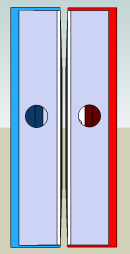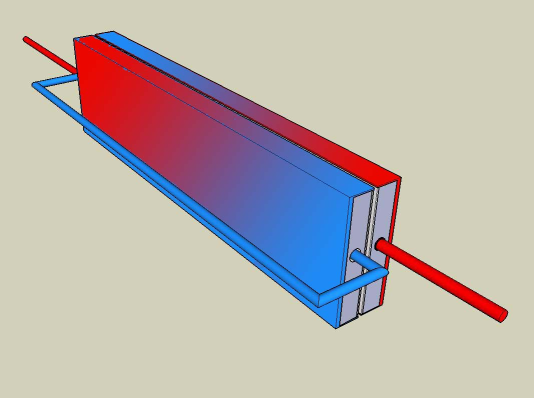Hello toto65,
For a peltier plate, the recoverable energy is of the order of about 10 to 15% of the power advertised in "normal" operation.
It's not much, but it's already not bad!
For the calopiles, it's not won in advance.
The site you give is the same, they are not able to provide any proto ...
The only thing I had seen was an American site which provided thermocouples and especially how to assemble them with an "honest" price.
Will have to do a search in my database ....
Obelix
Peltier-Seebeck effect generator
Another question.
Imagine Peltier plates sandwiched between U's.
Water is passed at 70 ° C in the red and at 12 ° C in the blue.
In pictures:

A piece of U removed.

Which joules are absorbed per plate?
If we produce 20W per plate! The temperature must have dropped.
In my example we use 2 plates but 10 plates?

Imagine Peltier plates sandwiched between U's.
Water is passed at 70 ° C in the red and at 12 ° C in the blue.
In pictures:

A piece of U removed.

Which joules are absorbed per plate?
If we produce 20W per plate! The temperature must have dropped.
In my example we use 2 plates but 10 plates?

0 x
Imagine a thermal voltaic panel on the seedbeck principle.
a 1m² panel.
we would use standard modules.
60x60x3.5mm
to make 1m² we would have 256 modules
In normal operation (Peltier) they consume 256 w
let's admit that they only give 10% or 25,6w per module
so 25,6x256 = 6656w.
Let's assume losses of 50% (I'm wide, right?)
We would get 3000w
40x40x3mm
1m² => 625modules
71w nominal => 7w inverted
7x625 = 4375w
50% => 2000w
A photovoltaic panel of equivalent surface produces 200w
can be 400w, (quality of gear).
 Am i wrong? Or?
Am i wrong? Or?
a 1m² panel.
we would use standard modules.
60x60x3.5mm
to make 1m² we would have 256 modules
In normal operation (Peltier) they consume 256 w
let's admit that they only give 10% or 25,6w per module
so 25,6x256 = 6656w.
Let's assume losses of 50% (I'm wide, right?)
We would get 3000w
40x40x3mm
1m² => 625modules
71w nominal => 7w inverted
7x625 = 4375w
50% => 2000w
A photovoltaic panel of equivalent surface produces 200w
can be 400w, (quality of gear).
0 x
a link:
http://rebellyon.info/article693.html
If you happened to download the document on the thermopile. I'm interested.
http://rebellyon.info/article693.html
It would be really nice to be able to find this skill because it would make it possible to realize a big project during the tour, namely to realize a thermopile
If you happened to download the document on the thermopile. I'm interested.
0 x
Toto: in my opinion on your square meter there will never be so much energy.
In photovoltaic solar it is something like 1000W / m² maximum.
So you can never have more, even if you have 256 modules.
Otherwise, a little higher up, someone had the idea of killing two birds with one stone: concentrating the light on a solar panel, itself mounted on the hot part of a pellet module.
I got better, a stone 3 shots
Same assembly as the previous one, except that the cold part of the pellet module is connected to an exchanger allowing to heat domestic hot water
In photovoltaic solar it is something like 1000W / m² maximum.
So you can never have more, even if you have 256 modules.
Otherwise, a little higher up, someone had the idea of killing two birds with one stone: concentrating the light on a solar panel, itself mounted on the hot part of a pellet module.
I got better, a stone 3 shots
Same assembly as the previous one, except that the cold part of the pellet module is connected to an exchanger allowing to heat domestic hot water
0 x
The 2 are strongly linked I think.
The 1000W is good for photovoltaics, and very good sun conditions. But the current panels only allow to recover a small part, in the 20% now I believe.
With a reflector yes, it would work. Besides with the pelletier it takes a lot of heat, so I think that concentration is mandatory.
There is a differential of maximum temperature on the pelletier or not, I don't remember?
The 1000W is good for photovoltaics, and very good sun conditions. But the current panels only allow to recover a small part, in the 20% now I believe.
With a reflector yes, it would work. Besides with the pelletier it takes a lot of heat, so I think that concentration is mandatory.
There is a differential of maximum temperature on the pelletier or not, I don't remember?
0 x
Yes there is a temperature difference, of the order of 70 ° c. It is necessary to cool the part which is not exposed to the sun.
With a water circuit as your example.
I redo the calculation for 1000w / m² of module.
1000 / 25.6 = 39 modules
1000 / 7 = 142 modules
The fact of bringing energy (cold part) will not increase the power per square meter?
Imagine that it is at -40 ° C to be convinced.
It is true that the sun provides 1000w / m², but cold water takes away calories. Can we imagine that it is energy?
Okay, it won't bring an extra 1000w to the system.
With a water circuit as your example.
I redo the calculation for 1000w / m² of module.
1000 / 25.6 = 39 modules
1000 / 7 = 142 modules
The fact of bringing energy (cold part) will not increase the power per square meter?
Imagine that it is at -40 ° C to be convinced.
It is true that the sun provides 1000w / m², but cold water takes away calories. Can we imagine that it is energy?
Okay, it won't bring an extra 1000w to the system.
0 x
It is the differential that provides energy. If we have 0 ° on the hot part and -100 ° on the cold part it will work too.
BUT the question I asked was whether there is a temperature differential not to be exceeded.
For example, will a solar concentration of 300 ° c on the hot part and a liquid cooling at 80 ° c on the cold part work and generate a lot?
BUT the question I asked was whether there is a temperature differential not to be exceeded.
For example, will a solar concentration of 300 ° c on the hot part and a liquid cooling at 80 ° c on the cold part work and generate a lot?
0 x
-
- Similar topics
- Replies
- views
- Last message
-
- 3 Replies
- 3292 views
-
Last message by Obamot
View the latest post
06/02/12, 13:19A subject posted in the forum : Electricity, electronics and IT Hi-Tech, Internet, DIY, lighting, materials and new
-
- 17 Replies
- 20994 views
-
Last message by izentrop
View the latest post
17/10/18, 14:39A subject posted in the forum : Electricity, electronics and IT Hi-Tech, Internet, DIY, lighting, materials and new
-
- 13 Replies
- 14614 views
-
Last message by Ahmed
View the latest post
30/11/21, 19:28A subject posted in the forum : Electricity, electronics and IT Hi-Tech, Internet, DIY, lighting, materials and new
Who is online ?
Users browsing this forum : No registered users and 186 guests



